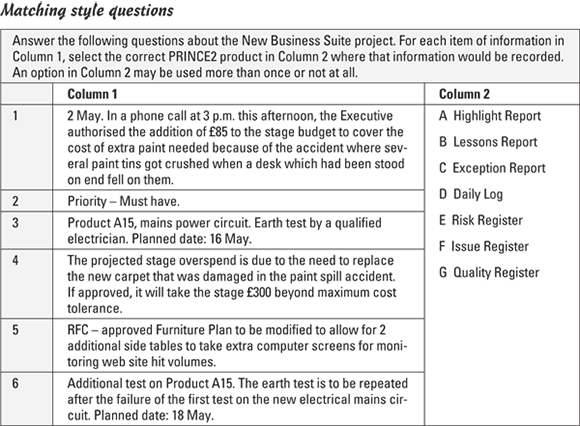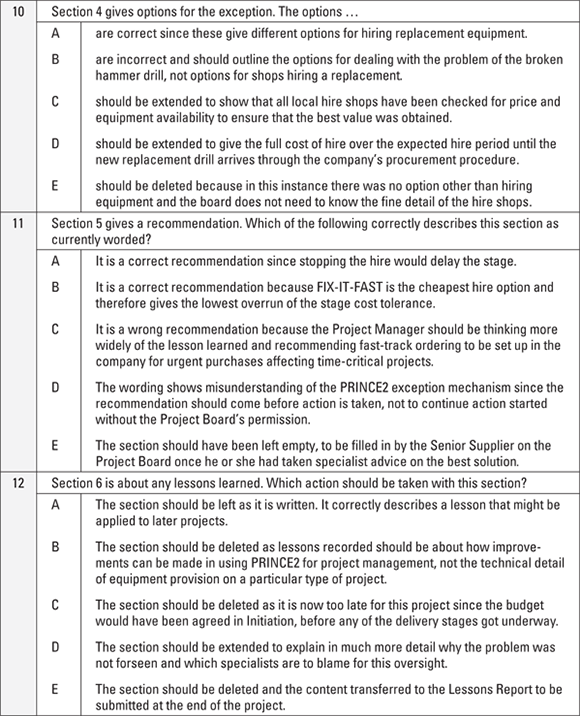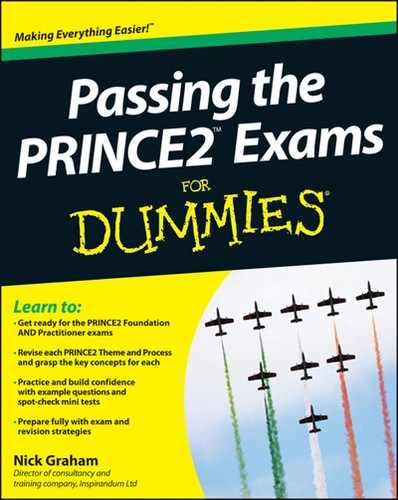Practising With Some Questions
Have a go with the questions in the next sections to check your understanding of PRINCE2 management products. Because the products cover the whole method, you should tackle these questions towards the end of learning PRINCE2, when you have covered everything or nearly done so. You’d find it a bit hard to get the right answer to a question on products in project closure if you were on the first day of your PRINCE2 studies and had only learned as far as Initiation.
For the Practitioner exam, you won’t get a whole section of the paper on management products. Instead, product-based questions can appear anywhere in the exam in a subject area that uses them. The Practitioner-level questions I provide here are to help in your revision of management products, no matter what theme or process they relate to.
Foundation-level questions
Try to answer these questions in eight minutes. Remember, read the questions carefully.
1. Which of the following is a progress report produced by a Team Manager?
![]() a) Team Progress Report
a) Team Progress Report
![]() b) Product Status Account
b) Product Status Account
![]() c) Highlight Report
c) Highlight Report
![]() d) Checkpoint Report
d) Checkpoint Report
2. Which of the following is a report that the Project Manager may ask for at any time during a project, rather than at set, timed intervals?
![]() a) Checkpoint Report
a) Checkpoint Report
![]() b) Exception Report
b) Exception Report
![]() c) Product Status Account
c) Product Status Account
![]() d) Highlight Report
d) Highlight Report
3. Which of the following forms part of the Project Brief?
![]() a) Daily Log
a) Daily Log
![]() b) Outline Business Case
b) Outline Business Case
![]() c) Risk Management Strategy
c) Risk Management Strategy
![]() d) Configuration Management Strategy
d) Configuration Management Strategy
4. Which of the following may be generated by a Team Manager?
![]() a) Lessons Report
a) Lessons Report
![]() b) Issue
b) Issue
![]() c) End Stage Report
c) End Stage Report
![]() d) Exception Report
d) Exception Report
5. Which of the following products is not produced during the Initiation Stage of a PRINCE2 project?
![]() a) Daily Log
a) Daily Log
![]() b) Benefits Review Plan
b) Benefits Review Plan
![]() c) Project Plan
c) Project Plan
![]() d) Communications Management Strategy
d) Communications Management Strategy
6. Which of the following statements are correct?
A. An Exception Report is produced by the Project Manager.
B. Highlight Reports are produced at regular time-based intervals.
C. Lessons Reports may be produced during a project as well as at the end of it.
D. The End Project Report is produced by the Executive.
![]() a) A, B and C
a) A, B and C
![]() b) A, B and D
b) A, B and D
![]() c) A, C and D
c) A, C and D
![]() d) B, C and D
d) B, C and D
7. Which of the following products is created on a stage boundary?
![]() a) Lessons Log
a) Lessons Log
![]() b) Risk Management Strategy
b) Risk Management Strategy
![]() c) Risk Register
c) Risk Register
![]() d) Configuration Item Record
d) Configuration Item Record
8. Which of the following statements is correct? The Lessons Log:
![]() a) Is updated only on stage boundaries and then at the end of the project
a) Is updated only on stage boundaries and then at the end of the project
![]() b) Includes lessons to be applied to the current project
b) Includes lessons to be applied to the current project
![]() c) Is created during the first delivery stage
c) Is created during the first delivery stage
![]() d) Must be maintained by the Senior Supplier
d) Must be maintained by the Senior Supplier
9. Which of these products is created in the process of Starting Up a Project?
![]() a) Risk Management Strategy
a) Risk Management Strategy
![]() b) Project Initiation Documentation (PID)
b) Project Initiation Documentation (PID)
![]() c) Project Product Description (PPD)
c) Project Product Description (PPD)
![]() d) Work Package
d) Work Package
10. Which PRINCE2 report is produced towards the end of a project?
![]() a) End Project Report
a) End Project Report
![]() b) Project Brief
b) Project Brief
![]() c) Benefits Review Plan
c) Benefits Review Plan
![]() d) Risk Register
d) Risk Register
Practitioner-level questions
There are two sets of questions in the area of management products to help you practise for the Practitioner exam. The first set contains examples of the sort of question mentioned earlier in the chapter, in which you’re presented with an item of information and you have to say which management product it belongs in. The second set gives examples of a style that’s quite hard work. You’re required to say whether each part of the product is correct and, if not, which of the options is the correct one to deal with the problem.
After reading the additional scenario for the project, allow 18 minutes for these questions.
Additional scenario
For the Practitioner questions in this chapter, please take into account the following additional project scenario information as well as the original information at the end of Chapter 2.
Set out below is a copy of an Exception Report for the project to prepare a suite of offices for a new e-commerce business unit. The report has just been prepared by the Project Manager, who’s about to send it to the members of the Project Board to inform them of a problem with equipment – a broken high-power hammer drill.
1. Exception title
002
2. Cause of the exception
Unforeseen spend for hire of a high-power hammer drill with an ‘SDS+’ feature for drilling and cutting into very hard brick and concrete.
3. Consequences of the deviation
Even though it will cause an overspend beyond tolerance on the stage, I had no choice but to hire a high-power SDS+ hammer drill to replace the Works Team’s SDS+ drill which broke beyond repair. The consequences of the deviation are a spend of £35 a day on the hire. A new high-power SDS+ hammer drill is being purchased by the Works Team out of its own budget, but the long Princess Projects Plc procurement process means that it’ll be a while before it arrives. Hiring a hammer drill meant that the structural alteration work could continue uninterrupted.
4. Options
The following hire options were considered, and we went with option 3:
1. Brinkworthy Tool Hire Shop: £40 per day, but a drill was not available for two days
2. ABC Builders Hire Department: £38 a day, but a drill not available for three days
3. FIX-IT-FAST Tool Hire Ltd: £35 a day, and a drill was available immediately
5. Recommendation
That the SDS+ drill hire continues with FIX-IT-FAST, because it’s cheaper.
6. Lessons
When planning the project, we didn’t think about equipment failure, because we were focused on the design of the new offices. It would be sensible to have a contingency budget allocation in projects to allow for equipment hire in the event of breakdown.
Warning: There may be errors in this Exception Report



Answers to the Foundation-level questions
1. d. Be careful not to confuse the Checkpoint Report with the Highlight Report. They are similar beasts – progress reports – but the management level is different.
2. c. The Checkpoint and Highlight Reports are both produced at set intervals. The Exception Report isn’t, but it’s produced by the Project Manager, not asked for.
3. b. You should know this, but even if you don’t, you should be clear that the strategies are produced in Initiation, not Start Up when the brief is being done. Logs and registers are stand-alone products and don’t form part of the brief or Project Initiation Documentation (PID). Putting those together, you may have been able to deduce that ‘b’ is the correct answer by ruling out the others. Such an approach is a perfectly valid strategy if you’re not sure of an answer, and part of the function of this question is to give an example of that elimination strategy.
4. b. Anyone can generate and submit an issue, and that includes Team Managers. The three reports are all produced by the Project Manager. The Team Manager can note a lesson on a Checkpoint Report, but doesn’t write a Lessons Report.
5. a. Remember, both logs – Daily and Lessons – are produced in Start Up. The other options in this question are all far too detailed for the rapid work of Start Up.
6. a. I always think that this is an unkind question style, because effectively you’re faced with four questions not one. Be careful not to lose track; to help prevent that you might like to write ‘T’ (true) or ‘F’ (false) against each statement as you work through the list. Remember, you can write on the exam paper.
7. d. The significant word here is ‘created’. The others may be updated but are not created on a stage boundary. Configuration Item Records are created as part of stage planning for the next stage where new products are defined at stage planning level. [Manual Table 17-1]. One of the functions of this question is to remind you to be very aware of every word in the question. It’s easy, especially when under time pressure, to miss the significance of words such as ‘created’ and ‘updated’.
8. b. In Start Up, entries are made in the Lessons Log for things from past experience which may be of value in the current project. In Start Up, the log is retrospective. From that point on, it’s used mostly to record lessons learned in the present project which may be of use to future projects.
9. c. If you’ve got as far as product planning when you’re reading this, you may correctly associate Product Descriptions with plans and so with Initiation onwards. However, this isn’t an ordinary Product Description but the Project Product Description (PPD). The PPD may be modified in Initiation and indeed later in the project as well, but it’s created in Start Up and forms part of the Project Brief.
10. a. Well, you’ve been working so hard on some fairly tough questions that I had to drop in an easy one. A report at the end of the project: the End Project Report. It’s a pity the Foundation exam isn’t as kind hearted. Actually though, once again there’s a learning point behind this question as well as kindness. The learning point is that some exam questions are very straightforward and, if you happen to know the answer, easy. Don’t expect everything to be difficult and go looking for some deep complexity when the answer is straightforward and staring you in the face.
Answers to the Practitioner-level questions
Matching-style questions
1. D. This is a good use of the Daily Log to reduce formal documentation.
2. F. A Request for Change (RFC) is a type of issue and has a priority. None of the other products listed in column 2, as defined in Appendix A of the PRINCE2 manual, have priority headings. The Lessons Log does, but the product in column 2 is a Lessons Report.
3. G. This is a quality action to be taken, so it’s listed in the Quality Register.
4. C. A projection that the stage will exceed tolerance is an exception. It would be escalated to the Project Board using an Exception Report.
5. F. Again, an RFC is a type of issue. The correct selection is Issue Register. It would also appear on the issue itself, but that isn’t an option in column 2.
6. G. The Quality Register again, this time for a new quality action that comes to light during a stage rather than one that was planned during stage planning.
Classic-style questions
The Exception Report example is completely wrong. The report should be submitted if the Project Manager does not have power to act (because to do so would exceed tolerance) and needs authority to take action. The report is not to recommend continuing action which is unauthorised. With any set of questions on a specific management product, it helps to look quickly at Appendix A of the PRINCE2 manual so that the right use of the product is fresh in your mind. The mistakes in the example then often jump out at you, and hopefully they did here. Having opened the manual at Appendix A, keep it open at the page while answering, so that you can glance back at it whenever you need to.
7. E. The title should describe the exception in overview – in this case a cost exception, although it can also include time exception. The error becomes very obvious if you have the manual open at the product and are looking at the explanation for the ‘Exception title’ section of the report. [Manual A10.2]
8. C. The cause of the deviation was the tool breakdown. The key word is ‘cause’. This breakdown will lead to delay, extra cost, or perhaps both, but that delay or overspending is a consequence, not the cause.
9. B. The section as written does not explain the consequences of the problem as it should, but rather is reporting the consequences of the unauthorised action already taken by the Project Manager.
10. B. This section should give the Project Board different options for dealing with the deviation. One option, for example, is to delay the project by waiting for the new drill to arrive through the procurement system rather than hiring one. That may not be an option that the Project Manager would recommend, but it’s an option nevertheless.
11. D. Answer D correctly explains the misunderstanding evident in the product.
12. A. The lesson is valid, although perhaps not very well thought through or worded. It’s rather better than the rest of the report though – but that’s not saying much. Clearly the Project Manager wasn’t trained by Nick Graham and Inspirandum Ltd!
